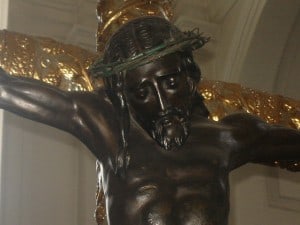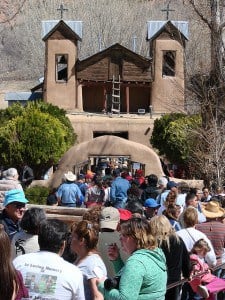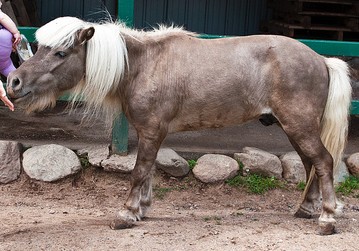I have two words for all my fellow Parks & Rec fans. Two words guaranteed to send a thrill down the spine of anybody who loves Amy Poehler’s upbeat comedy series.
Li’l. Sebastian.
For the uninitiated, Li’l Sebastian is a mini-horse 1 who showed up unannounced in episode sixteen of season three of the show. Well, unannounced in the sense of being introduced without any explanation. In the episode, he is given an extravagant introduction. Leslie Knope tells her Parks & Recreation coworkers that she has a surprise for them, “and it is possibly the best thing to potentially ever happen to anyone anywhere in the history of the universe.” That something is Li’l Sebastian:
And all along, we have no idea why a mini-horse should cause such an explosion of good cheer. Only one character, the out-of-towner Ben Wyatt, seems to not be in on the fun. He stands in for all of us when he asks what he is missing about this small horse. The first time I saw the episode, I assumed that I had skipped some earlier episode where a reason for Li’l Sebastian’s fame had been given. I hadn’t.
The townsfolk of Pawnee never give any real explanation, just raw enthusiasm. But ultimately, that is enough. Soon I don’t care why everybody loves Li’l Sebastian, nor do I wonder what I am missing out on. Now it seems as obvious to me as it did to the rest of Parks crew. Li’l Sebastian is just awesome, one of the best things to happen on this series… but don’t ask me to explain why.
***
There are definitely “Li’l Sebastians” in all of our lives. You know, the inside jokes that only certain friends can get, the meals that remind the whole family of Grandma, that restaurant that is for special occasions now since it is where you met that special someone.
I first noticed how this worked while traveling in Central America as a young Jesuit. One day, less than a month after I had arrived to work in a parish in the rural south of Belize, the pastor told me that I should save the next evening to visit and participate in the prayer service that would be held in the church for “Nuestro Señor de Esquipulas” (Our Lord of Esquipulas).
I had no idea what that meant, but I dutifully planned to attend. The pastor explained to me that the image of the crucifixion in the front of the church was a copy of the one in Esquipulas, a town in the neighboring country of Guatemala. It is an image of the “Cristo Negro”—the black Christ—since the wood of which it is made is quite dark, helping many of the people of Central America who come in various shades of tan, brown, and “black” identify with a Jesus who looks more like them than the European colonial powers. This fact certainly helped it make the transition from Spanish-speaking Guatemala to Belize, where English is the lingua franca.

Señor de Esquipulas, by Keneth Cruz Flickr CC
Even armed with that information, I had no way to be prepared for what I would encounter. The church was full. Full, not for the prayer service, as it often was for Sunday mass, but packed for the entire night. 2 But the image that has stayed with me until this day is the candles. So many candles! Not one, not two, but three levels of candle banks on each side of the altar. And then, when those filled up, the candles placed on the floor all around the altar. Each one representing a prayer. Each one representing a person’s devotion. I decided on that day that I would have to visit this site which could inspire such a riot of dancing orange devotion. The enthusiasm of these people had become my own, just the same way that a quaintly named mini-horse had become my favorite sitcom character.
***
And I did visit Esquipulas. It took me five years and no little amount of Spanish study to find a suitable opportunity to jaunt off into rural south Guatemala, but I did it. There, of course, I saw candles upon candles. After all, several million people come to visit the shrine each year. It was a powerful spiritual experience, but it still took several years before the full significance of these events sank in.
After visiting Esquipulas, I taught high school in Denver. Toward the end of my second year there, I was chatting with a student, “Ray,” after school. Ray was a wonderful young man, lively and much beloved by faculty and classmates, but he had not had an easy life. This turmoil in his life meant that many days in class he was not just high-school-sophomore hyper (itself a feat) but more like hummingbird-discovering-the-joys-of-espresso hyper.
That day we were having a casual conversation, though, and I had just explained that I planned on visiting New Mexico over the summer. “Mister,” he said, “if you go to New Mexico, you have to go to the shrine in Chimayo.” My ears perked up. “My dad takes me there every year,” he explained. “It is the only place I have ever felt peace.”
My heart melted at that instant. I wanted Ray to have peace more than anything. If this place had given it to him, even if only for an hour, I wanted to be there. I wanted to be there not so much for my sake, or even for the sake of religious significance, but for the sake of Ray. I wanted to touch this place that had touched him so deeply. The same thing that had happened all those years ago in Belize was happening again. Something in the quality of Ray’s voice reminded me of that fire of devotion that had changed me years before, and just as before, it awakened my own fire, my own devotion.

Chimayo by Denise Womack-Avila, Flickr
When I finally did arrive in Chimayo (of course I went!), I discovered the peace Ray had spoken of. Turns out, he was not the only person the shrine had offered healing to. The walls were festooned not only with the type of religious kitsch I would expect, but also with crutches that had been left by people who had visited the shrine and experienced a healing. They then came back and left their crutches behind (or walkers, or even the occasional handicapped parking tag!).
These people were testifying to the power of the shrine to work miracles, but for me, they were also testifying to the power of their devotion to change my own life. Too often, I think of myself as a “self-made” man with regard to my religious/spiritual life. I know what I like in prayer, and I know many practices and disciplines to help me get in touch with God, so it can seem like I am the most important person for deciding what my spirituality will be like.
Reviewing this history of pilgrimages and shrines, however, I must recognize that none of them were my idea at all. It was other people who have stirred me up and showed me what it meant to connect to God. Nor did they do so by enrolling me in a catechism class or theology lecture. Devotion, whether to God or to comical mini-horses, is something that we learn via the example and the experience of others, rather than long-winded explanations. When we review our own experience of God, we find everywhere the well-placed candles, the timely words, the abandoned crutches that others have left behind in our hearts.
– // –
Cover image by Sandor Weisz, Flickr Creative Commons.


